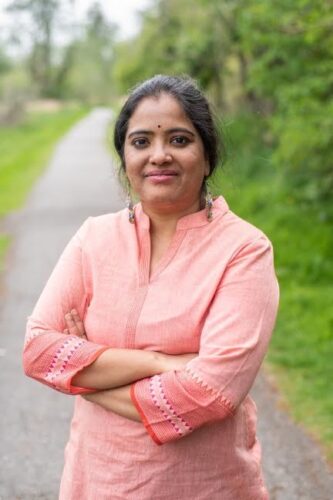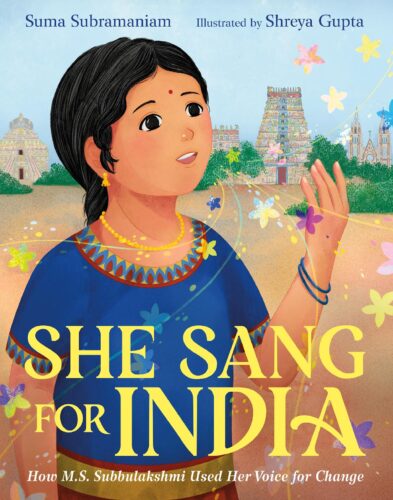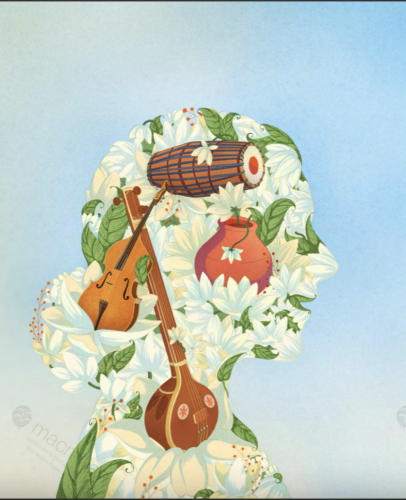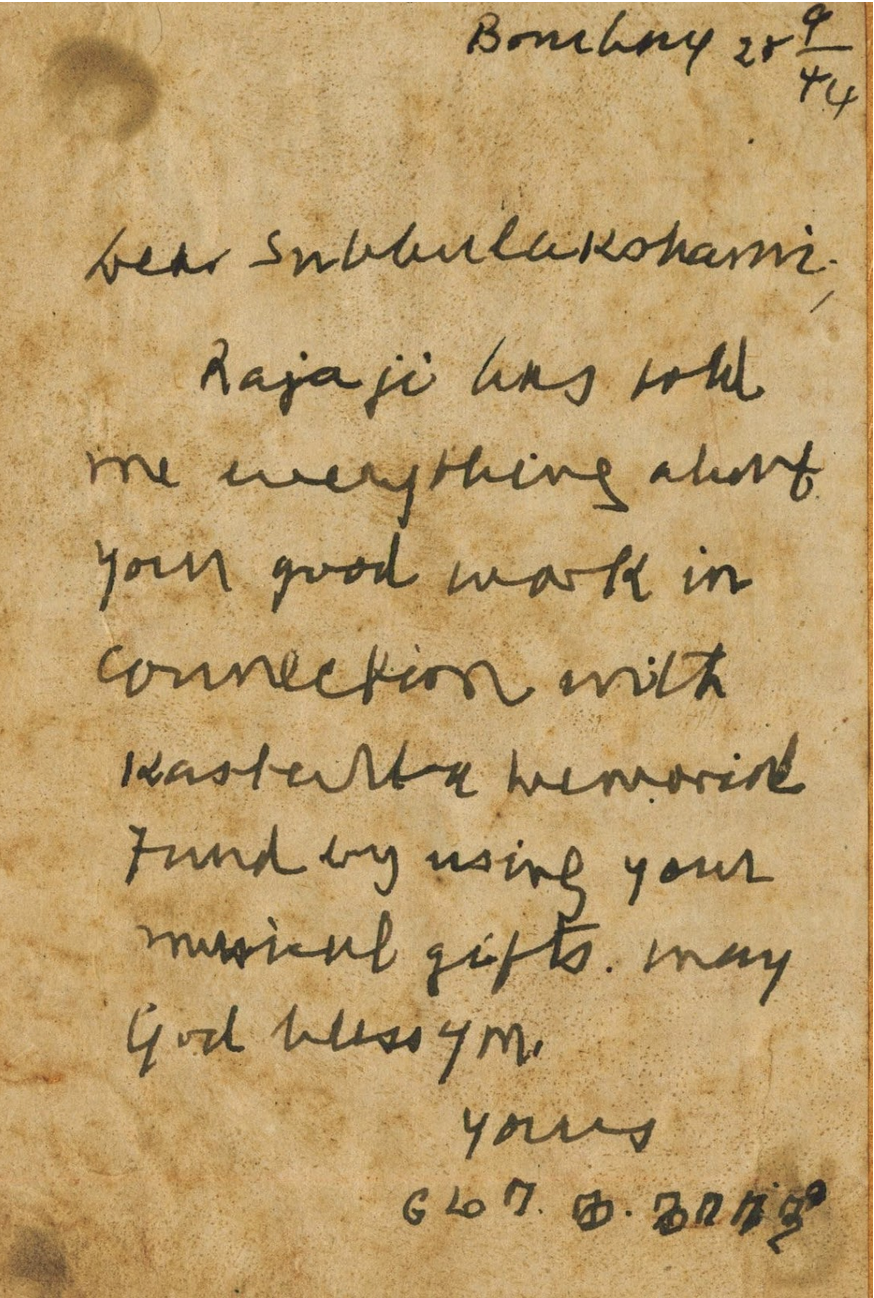Heralding the Heralds: A She Sang for India Interview with Suma Subramaniam
So how will you be celebrating the birthday of M.S. Subbulakshmi tomorrow? In the possible event that you do not know who Ms. Subbulakshmi is, I am happy to report that once again picture book biographies have come to the rescue. Long gone are the days when the same five people would get biographies for kids over and over again. Today, we celebrate a book that brings attention to one of India’s foremost singers.
Here’s how the book SHE SANG FOR INDIA: HOW M.S. SUBBULAKSHMI USED HER VOICE FOR CHANGE was described to me:
“Before M.S. Subbulakshmi was a famous Carnatic singer and the first Indian woman to perform at the United Nations, she was a young girl with a prodigious voice.
But Subbulakshmi was not free to sing everywhere. In early 1900s India, girls were not allowed to perform for the public. So Subbulakshmi busted barriers to sing at small festivals. Eventually, she broke tradition to record her first album. She did not stop here. At Gandhi’s request, Subbulakshmi sang for India’s freedom. Her fascinating odyssey stretched across borders, and soon she was no longer just a young prodigy. She was a woman who changed the world.
SHE SANG FOR INDIA discusses key historical figures and moments such as Gandhi, and British partition of India and Pakistan, which nicely tie into school and library curriculums. It also includes extensive backmatter on Subbulakshmi’s life, and Suma’s relationship with the story (note: she has done extensive research and is in contact with Subbulakshmi’s family). There is really no better time for young readers to delve into a book highlighting social justice and intersectional feminism”
Today we’re talking with author Suma Subramaniam about Subbulakshmi and the the complex process involved in simplifying a complicated life:
Betsy Bird: I appreciate your speaking with me today! I was unaware of M.S. Subbulakshmi’s story until I read your book. What inspired you to tell her story for kids?
ADVERTISEMENT
ADVERTISEMENT

Suma Subramaniam: Thank you so much for having me, Betsy! The inspiration for She Sang For India came from listening to M.S. Subbulakshmi’s music all of my life. I grew up listening to her voice first thing in the morning almost every day of my childhood.
M.S. Subbulakshmi’s story is one of quiet strength. Her life is an example of how a small-town girl with a great devotion to her craft realized her dream. In her time, it was rare for a woman to make a mark in the world. Like many other women in her era, there were rules by which Subbulakshmi had to live. A girl could be told she could be anything she wants to be, but who is ever content with living a rule-driven life?
Subbulakshmi broke the rules, led by unparalleled dedication and love for music. She used her voice for change and peace for well over seven decades of her music career. Through her life, we can learn that the ability to heal ourselves and the world is within us.
This inspired me to tell her story for children.
BB: In the past, it could be incredibly difficult for anyone to write a picture book biography and get it published here in the States if that person wasn’t already incredibly well-known. A shift happened around 10-15 years ago that changed all of that. With that in mind, did you have difficulty finding a publisher for SHE SANG FOR INDIA or was the process smooth for you?
SS: The process wasn’t easy. My wonderful agent, Miranda Paul loves to track data so I have it for you. It took me 8 years to get this story from idea to publication.
14 total rejections after being agented and several prior to that. 3 “no responses” (which could also be considered as rejections) and 1 YES. That’s 17 to 1 if we don’t count the rejections I received during pre-agent times. But all it took was one yes. It came from an editor who absolutely loved Subbulakshmi’s story and wanted it to be out in the world. The book was acquired in 2020 and it took two more years to get here.
Like M.S.’s life, this journey took patience and time. It had several rounds of revision, perseverance of keeping the manuscript out there, a persistent agent looking for the right editor and publishing house, and two brilliant editors, Elizabeth Lee and Trisha De Guzman, who championed this book all the way to the finish line.

BB: I’m always curious about the writing process. Considering that you had the whole of Subbulakshmi’s life to take into account, how did you decide which elements would be the right ones for such a limited format as a picture book bio?
SS: It took a long time to pare down the story of this remarkable woman into a lyrical and poetic picture book biography of 40 pages. I’m extremely grateful to all of the beta readers who read several versions of the manuscript and offered valuable critique.
Subbulakshmi lived simply throughout the 1900s. Her humility and love for Carnatic music was the lifeline of her soul and she followed it for more than seven decades. To write her story in a format that children would understand was challenging. The research process was long and also included an interview with her family. I used poetic devices, lyrical text, and easy-to-understand language to tell her story.
I wrote this story with a single-minded goal to encourage young readers to learn an important lesson from her life: to use their voice for the good of the world.
The editorial team and I agreed that Subbulakshmi’s fascinating musical journey was about social justice. I picked three to four major incidents and events in her life that had huge social impact and I dived deep into those events to write my scenes. The spreads in the book are divided into roughly three to four sections:
- What she did in her childhood
- How she broke societal tradition as a young adult
- How she contributed toward India’s freedom struggle against the British
- How she became the first Indian musician to perform at the United Nations
Everything else went into the backmatter. I have an author’s note at the end of the book that covers her inspirational life along with timelines.

BB: Was there anything you initially wanted to include that didn’t make the final cut?
SS: There are many scenes that didn’t make it to the final cut. Here are a few of them.
1. Before Subbulakshmi turned to classical music full-time, she also acted in plays and movies. Even though there were only a few roles for female singers, she performed in them. She became a singer on stage and an actor on the screen. Her first film was based on social reform and was highly successful.
2. One of her songs, Katriniley Varum Geetham (the song wafting through the breeze) from the film, Meera, made her a national star. It became so popular that it is still sung in concerts everywhere.
3. At Gandhi’s request, Subbulakshmi recorded a song for his last birthday, four months before his assassination, and she sent it to him over night. After listening to it, Gandhi had announced to the entire country of India that “M.S., when singing, comes closer to God and the same happens to those who listen to her.”
4. Another one that didn’t make it to the final cut was a letter shared by M.S. Subbulakshmi’s family. This letter was written to her by Gandhi when India was in deep turmoil while fighting for independence.

BB: Let’s talk about the art a little. Shreya Gupta has a very distinct style, and not one that you might initially think of when you think of biographies. It is incredibly kid-friendly. Did you envision the art at all as you wrote the text? What do you think of the final product?
ADVERTISEMENT
ADVERTISEMENT
SS: Thank you for the kind words about the art. Shreya has captured Subbulakshmi’s story beautifully and has brought her to life on the pages of the book. I’m grateful to the art direction team at Farrar, Straus, & Giroux for making the process collaborative and hands-on with Shreya right from the beginning. It was needed for the project. I shared research material for the art. We went through many passes. Shreya studied about Subbulakshmi, and I also collaborated with her on email and video chat. The end product is rewarding as we see it now. I’m so very grateful for her beautiful talent and for being an amazing partner on this project.
BB: And finally, what is your favorite Subbulakshmi song? Why?
SS: This is tough because there are so many. One of my most favorites of all times is a Tamil song called Kurai Ondrum Illai, written by Rajaji, who was a freedom fighter and the last Governor General of India.
Kurai Ondrum Illai means I have no grievances. The song implies that the composer didn’t crave anything out of the universe. He was content in simply experiencing the divine for what it was. Subbulakshmi lived her life in a similar vein. She experienced the divine in her music, and she gave it her all. She had no yearnings for anything rich or fancy. Instead, she spent her whole life in long hours of music practice. She used her voice and performed all over India and the world for peace.
The link to the song is here:
I’d like to thank Suma for taking the time to answer my questions today. Thanks too to Kelsey Marrujo and the folks at Macmillan for setting up this interview today. She Sang for India releases November 8th so be sure to look for it then!
Filed under: Interviews
About Betsy Bird
Betsy Bird is currently the Collection Development Manager of the Evanston Public Library system and a former Materials Specialist for New York Public Library. She has served on Newbery, written for Horn Book, and has done other lovely little things that she'd love to tell you about but that she's sure you'd find more interesting to hear of in person. Her opinions are her own and do not reflect those of EPL, SLJ, or any of the other acronyms you might be able to name. Follow her on Twitter: @fuseeight.
ADVERTISEMENT
ADVERTISEMENT
SLJ Blog Network
Books on Film: GUESS HOW MUCH for This Picture Book
Mr. Muffins Defender of the Stars | This Week’s Comics
Heavy Medal Mock Newbery Reader’s Poll
When Book Bans are a Form of Discrimination, What is the Path to Justice?
Changing Stereotypes about Mental Health in Safe Harbor, a guest post by Padma Venkatraman
Our 2025 Preview Episode!
ADVERTISEMENT








Wow, what a challenge to profile such a full and inspiring life in a picture book. Looking forward to getting my copy when it comes out. Congratulations Suma Subramaniam and Shreya Gupta, and thank you Betsy for highlighting the story.